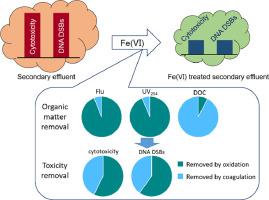Water Research ( IF 11.4 ) Pub Date : 2021-09-15 , DOI: 10.1016/j.watres.2021.117667 Qian-Yuan Wu 1 , Xue-Si Lu 1 , Ming-Bao Feng 2 , Wen-Long Wang 1 , Ye Du 3 , Lu-Lin Yang 1 , Hong-Ying Hu 4

|
Ferrate(VI) (Fe(VI)) can oxidize individual pollutants, but the pollutant oxidation does not necessarily result in toxicity reduction. Besides, Fe(VI) resultant Fe(III) particles has previously been used to remove heavy metals, but its influence on organic matter and toxicity of wastewater is unknown. This study investigated influence of Fe(VI) on the cytotoxicity and DNA double-strand break (DSB) effects of secondary effluents from wastewater treatment plants to Chinese hamster ovary cells. Adding 5.0 mg/L Fe(VI) as Fe reduced the cytotoxicity and genotoxicity of secondary effluents by 44%–71% and 40%–59%, respectively. The toxicity reduction could be explained by the alleviation of oxidative stress in cells when they were exposed to the Fe(VI)-treated organic matter. Oxidation and coagulation accounted for 60 and 40% of the reductions in cytotoxicity and genotoxicity, demonstrating that both oxidation and coagulation processes can play important roles in reducing toxicity. Molecular weight (MW)-distribution analysis showed that the oxidation process was favored for removing ultraviolet absorbance and fluorescence intensity of organic matter, while the coagulation process removed more dissolved organic carbon (DOC), especially the DOC of fractions with MW < 500 Da. Compared with ferric chloride, the Fe(VI) resultant Fe(III) showed better coagulation performance on organic matter, cytotoxicity and genotoxicity removal, because of the different particle sizes and crystalline structures. This study highlights the benefit of using Fe(VI) in advanced treatment as Fe(VI) reduced the overall toxicity of secondary effluents.











































 京公网安备 11010802027423号
京公网安备 11010802027423号